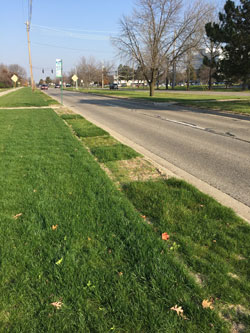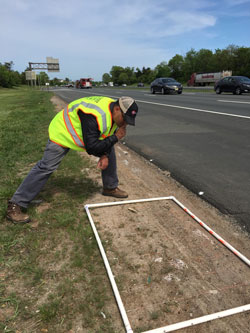Michigan State University
Vibrant green grass along roadways is a common sight across urban and rural landscapes in Minnesota and many other states, but its survival is a significant challenge—especially in cold climates. Roadway salt and other stressors can cause turfgrass installations to fail, requiring expensive reseeding or sodding efforts.
For more than a decade, University of Minnesota researchers have been conducting projects aimed at solving this problem by identifying best management practices for turfgrass establishment and recommending new species and cultivars that perform best in harsh roadside conditions. As part of these studies, researchers have tested various turfgrass species at multiple sites in Minnesota. However, year-to-year weather variability doesn’t allow for test sites in a single state to provide adequate information about turfgrass tolerances to many roadside stressors.
To address this challenge, U of M researchers directed a coordinated testing effort across five states—Michigan, Minnesota, Nebraska, New Jersey, and Wisconsin—that allowed for the simultaneous evaluation of stressors common to roadsides in cold climates. The pooled-fund project was led by the Minnesota Department of Transportation (MnDOT), with additional funding from the Michigan, Nebraska, New Jersey, and Wisconsin departments of transportation.
“The development of resilient turfgrass species and mixes is most effectively accomplished as a collaboration among cold climate states,” says Dwayne Stenlund, erosion control specialist at MnDOT. “Working across state lines, we can simultaneously test many species and mixes across a wide range of soil and weather conditions.”
In all five states, researchers tested 50 individual cultivars and 10 standard turfgrass mixes across several growing seasons. The cultivars were chosen through breeder recommendations and public data that indicated potential use as a roadside turfgrass.
Rutgers University
Researchers in each state seeded plots in two locations in 2016: an urban or suburban street with a curb and a rural highway without a curb. Plots were assessed in October 2016, April and October 2017, and April 2018, and data about cultivar successes and failures at each location were stored on a project website to assist agencies in choosing the best turfgrass species for their roadway sites.
“This multistate research project is the first to provide participating DOTs with unbiased, up-to-date information about the performance of turfgrass cultivars and mixtures used on roadsides in the northern US,” says Eric Watkins, professor of horticultural science at the U of M and the project’s principal investigator.
Although turfgrass establishment varied by state, general findings show that fine fescues perform well at urban sites and are more tolerant of salt than other species. Results also suggest that sites with high amounts of salt usage would benefit from mixtures incorporating alkaligrass. In addition, the study highlighted the importance of multi-site testing and difficulties establishing turfgrass: only 6 of the 10 sites resulted in first-year data because of weather and human interference.
Watkins says future studies evaluating optimal cultivars, species, or mixtures for roadsides should continue including multi-site testing for research projects. Such studies could be coordinated with the same group of researchers and even expanded to include other interested states. Researchers could also consider partnering with the National Turfgrass Evaluation Program to leverage its existing national turfgrass cultivar testing infrastructure.




